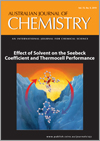
Australian Journal of Chemistry
Volume 72 Number 9 2019

Platinum has been an almost uniquely important element in the history of coordination chemistry. Platinum and its complexes continue to be hugely important in applications ranging from catalytic converters to cancer chemotherapy and is a focus of much work on electrocatalysts for new energy systems.
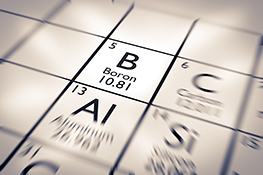
2019 is the International Year of the Periodic Table of Chemical Elements (IYPT 2019), as declared by the United Nations General Assembly. This invited paper on boron is one in a series of essays about the chemical elements.
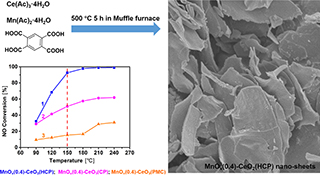
Well defined MnOx-CeO2 nanosheets with porous structures obtained by a homogeneous coordination precipitation method exhibit a high NO removal efficiency above 90 % in the SCR reaction at a low temperature of 150°C.
CH19080Effect of Structure Change on Luminescent Properties of CsPbBr2I Perovskite Nanocrystals after Heat Treatment
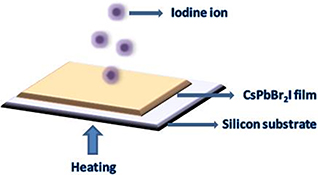
CsPbBr2I (CPBI) perovskite nanocrystals (NCs) were prepared by hot injection and the effect of temperature (below 400 K) on its structure and luminescence performance was studied. The results showed that with the increase of heat treatment temperature, partial iodide ion precipitation occurred an the lattice constant and grain size both changed to some extent, which eventually led to the change of the CsPbBr2I perovskite NC’s morphology and optical properties.
CH19047Solubility of Cellulose in Binary Mixtures of 1-Alkyl-3-methylimidazolium Acetate and Dimethyl Sulfoxide: Influence of Alkyl Chain Length in the Cation
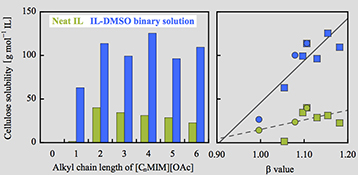
Cellulose solubility in the binary system of ionic liquid (IL) 1-alkyl-3-methylimidazolium acetate ([CnMIM][OAc]) and dimethyl sulfoxide (DMSO) was greater than that in neat IL ([CnMIM][OAc]), with the best solubility at n = 4 and 2 respectively. Furthermore, the cellulose solubility in both systems was correlated with the β values (hydrogen bond basicity).
CH19117PdII Immobilized on Ferromagnetic Multi-Walled Carbon Nanotubes Functionalized by Aminated 2-Chloroethylphosphonic Acid with S-Methylisothiourea (FMMWCNTs@CPA@SMTU@PdII NPs) Applied as a Highly Efficient and Recyclable Nanostructured Catalyst for Suzuki–Miyaura and Mizoroki–Heck Cross-Coupling Reactions in Solvent-Free Conditions
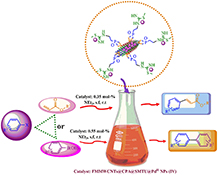
The high performance of FMMWCNTs@CPA@SMTU@PdII NPs (IV) as an efficient nanostructured catalyst for C–C cross-coupling reactions in green medium is presented.
CH19026Zinc-Containing Coordination Polymer as a Suitable Precursor for Solid State Synthesis of ZnO
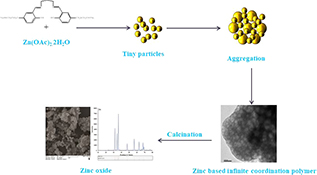
Synthesis, structural characterisation, and thermal behaviour of new infinite coordination polymer nanoparticles based on Zn2+ ions and bi-carboxylic acid functionalized salpn by a simple precipitation route was reported. This coordination polymer is a good precursor to prepare ZnO.
CH19222Prototropic Tautomerism and Some Features of the IR Spectra of 2-(3-Chromenyl)-1-hydroxyimidazoles
 , Tatiana Yu. Koldaeva, Vitaly S. Mityanov, Vladimir S. Miroshnikov, Elizaveta I. Basanova and Valery P. Perevalov
, Tatiana Yu. Koldaeva, Vitaly S. Mityanov, Vladimir S. Miroshnikov, Elizaveta I. Basanova and Valery P. Perevalov
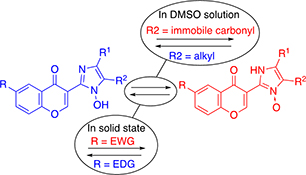
1-Hydroxyimidazoles may exist as two prototropic tautomers: N-hydroxyimidazoles and imidazole N-oxides. By means of IR spectroscopy, it was demonstrated that in the 2-(3-chromenyl)-1-hydroxyimidazole series in the solid state, the increase in general electron-withdrawing effect of the chromenyl moiety leads to the prevalence of the imidazole N-oxide tautomer. In d6-DMSO solution, the substituents in the chromenyl ring have no influence on the equilibrium shift.
CH19245The Effect of Solvent on the Seebeck Coefficient and Thermocell Performance of Cobalt Bipyridyl and Iron Ferri/Ferrocyanide Redox Couples
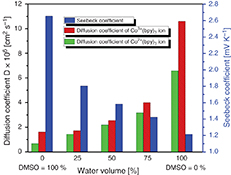
Thermoelectrochemical cells are an emerging technology for harvesting waste heat, but the influence of redox couple and solvent type on the physical, electrochemical, and device performance of the redox electrolytes is not well understood. Here, we report the use of a cobalt-based and an iron-based redox couple to investigate the effect of solvent on the Seebeck coefficient, diffusion rate, and cell performance.
CH19164Facile Preparation of Iron-Manganese Oxide@Diatomite Composite for Effective Removal of Vanadium from Wastewater
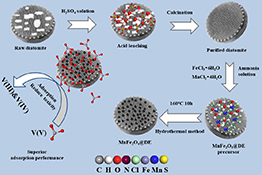
A novel iron-manganese oxide@diatomite composite (MnFe2O4@DE) with enhanced adsorption capacity towards vanadium(v) was successfully synthesised by a hydrothermal method. The present study should inspire the exploration of a similar novel design to synthesise other highly efficient adsorbents for better applications in addressing environmental pollution issues.



